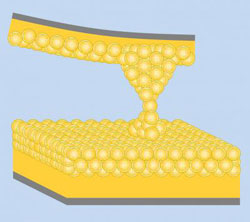Narrowest bridges of gold are also the strongest, study finds

A bridge made of a single atom of gold has twice the strength of bulk gold, according to new UB research. Credit: University at Buffalo<br>
At an atomic scale, the tiniest bridge of gold — that made of a single atom — is actually the strongest, according to new research by engineers at the University at Buffalo's Laboratory for Quantum Devices.
The counterintuitive finding is the result of experiments probing the characteristics of atomic-scale necks of gold that formed when the pointed, gold tip of a cantilever was pushed into a flat, gold surface. An examination of these tiny, gold bridges revealed that they were stiffest when they comprised just a single atom.
The study was published in June in Physical Review B by a trio of UB researchers: postdoctoral fellow Jason Armstrong and professors Susan Hua and Harsh Deep Chopra, all in UB's Department of Mechanical and Aerospace Engineering. Support for the work came from National Science Foundation grants No. DMR-0706074 and No. DMR-0964830.
As engineers look to build devices such as computer circuits with ever-smaller parts, it is critical to learn more about how tiny components comprising a single atom or a few atoms might behave. The physical properties of atomic-scale gadgets differ from those of larger, “bulk” counterparts.
“Everyday intuition would suggest that devices made of just a few atoms would be highly susceptible to mechanical forces,” the team said. “This study finds, however, that the ability of the material to resist elastic deformation actually increases with decreasing size.”
Another observation the team made while studying the tiny gold necks: abrupt atomic displacements that occur as the gold tip and surface are drawn apart are not arbitrary, but follow well-defined rules of crystallography. More scientific highlights of the work are summarized in the Physical Review Focus of the American Physical Society at http://focus.aps.org/story/v27/st24.
UB's Laboratory for Quantum Devices, led by Chopra and Hua, works on mapping the evolution of various physical properties of materials — including mechanical, magnetic and magneto-transport behavior — as sample sizes grow from a single atom to bulk.
This complicated task requires technology capable of capturing a single or few atoms between probes, and further pushing and pulling on the atoms to study their response.
The sophisticated technology that Armstrong, Hua and Chopra invented and built to accomplish the research was recently licensed to Precision Scientific Instruments Inc., a Western New York start-up company founded by the leaders of Murak & Associates LLC, a management consulting practice; SoPark Corporation, an electronics service manufacturer (ESM); and The PCA Group, Inc., a consulting firm that offers total technology solutions.
“The instruments and methods are incredibly precise and capable of deforming the sample at the picometer scale (about 100 times smaller than an atom), which means literally stretching the bond lengths, and simultaneously measuring the forces at the piconewton level, as well as various other properties. As a very broad perspective, by enabling researchers to probe the very small, the technology could speed advances in fields ranging from satellite communications to health care,” said Gerry Murak, president and cofounder of Precision Scientific Instruments, Inc.
“Small is exciting, and atomic scale devices are the new frontier of technology. Metrology systems capable of probing the behavior of atomic-scale devices are sorely needed, and this technology gives us a unique platform,” Murak said.
The University at Buffalo is a premier research-intensive public university, a flagship institution in the State University of New York system and its largest and most comprehensive campus. UB's more than 28,000 students pursue their academic interests through more than 300 undergraduate, graduate and professional degree programs. Founded in 1846, the University at Buffalo is a member of the Association of American Universities.
Media Contact
More Information:
http://www.buffalo.eduAll latest news from the category: Studies and Analyses
innovations-report maintains a wealth of in-depth studies and analyses from a variety of subject areas including business and finance, medicine and pharmacology, ecology and the environment, energy, communications and media, transportation, work, family and leisure.
Newest articles

Combatting disruptive ‘noise’ in quantum communication
In a significant milestone for quantum communication technology, an experiment has demonstrated how networks can be leveraged to combat disruptive ‘noise’ in quantum communications. The international effort led by researchers…

Stretchable quantum dot display
Intrinsically stretchable quantum dot-based light-emitting diodes achieved record-breaking performance. A team of South Korean scientists led by Professor KIM Dae-Hyeong of the Center for Nanoparticle Research within the Institute for…

Internet can achieve quantum speed with light saved as sound
Researchers at the University of Copenhagen’s Niels Bohr Institute have developed a new way to create quantum memory: A small drum can store data sent with light in its sonic…





















